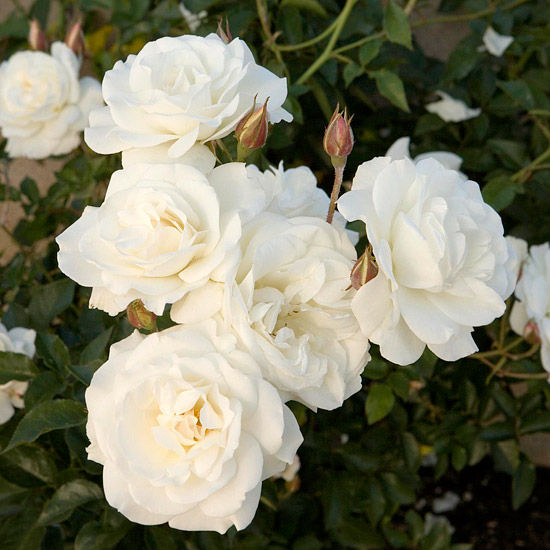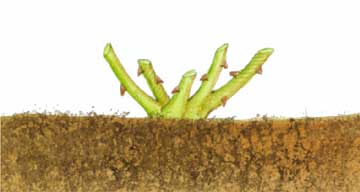






Hybrid Teas and Grandifloras. By winter, hybrid tea roses and grandifloras are generally 8 to 10 feet tall and looking rather lanky. You can prune these canes (on an established bush) 2 to 4 feet but, in general, leave 4 to 5 major canes with an average height of 3 feet. Remove the older canes; it will trigger the rose bush to attempt basal breaks (new cane growth) in the spring. This regenerative process is fundamental to the health of the bush.
continue reading belowFloribundas and Polyanthas. Since floribundas and polyanthas are mainly for garden display rather than cut flowers, you can allow more older canes to remain for increased flower production. Cut back about one third of the year's new growth and leave substantially more stems than you would for a hybrid tea. By nature, floribundas and polyanthas produce large numbers of flowers. Leaving a greater number of canes enhances the ability of the rose bush to produce the maximum number of flowers.
Miniature Roses. Most miniature roses are grown on their own roots. There is no bud union and no suckers. Precise pruning of miniature roses is very labor intensive, and many rosarians simply use a hedge clipper to trim off the tops at a foot above the soil (height varies with the variety). After such treatment, remove any twiggy growth and open up the center of the plant to increase air circulation.
Old Garden Roses and Shrubs. When pruning old garden roses, don't treat them as modern hybrid teas or floribundas. For maximum blooms, pruning should be more of a light grooming than severe. Prune only last year's growth; prune one-time bloomers immediately after flowering; prune one-time bloomers immediately after flowering; prune repeat bloomers in winter or early spring. After a few years, however, this practice makes for a very lanky bush, so each year thereafter prune back some of the oldest canes to promote basal and post-basal breaks. Keeping a proper balance between new growth and continuing old growth patterns is the secret to growing old garden roses.
Climbers and Ramblers. Climbers will generally not flower profusely unless the canes are trained on a horizontal plane. Cut the long-established canes to about the place where they are slightly thicker than a pencil. Then, cut each side stem that has flowered to the lowest possible five-leaflet stem, about 1 to 2 inches from the main cane. This process will cause the cane to flower along its complete length for a spectacular spring display.
Follow these suggestions in order to reduce the potential for disease as well as to encourage vigorous new growth:
1. Thoroughly clean the rose beds of dead leaves and other debris. You will reduce the potential for various insects and fungi to survive the winter by eliminating the places in which they hide. Bag all pruned material from the bushes. Don't use rose stems for mulch or compost; many fungal spores can invade the stems and cause reinfections when the warmer weather returns.
2. To ensure the destruction of all insects and fungi, apply a dormant pesticide or fungicide spray immediately after pruning -- when there are no eyes developing. Use the old-fashioned oil-and-sulfur spray to help destroy both powdery and downy mildew spores residing in the soil and on the canes. Inorganic sulfur compounds are available at garden centers. Follow instructions on the label to mix with horticultural oil.
3. After brushing the bud union with a wire brush to remove the old bark, cover the bud union with about 6 to 10 inches of the surrounding mulch. This protective mound of mulch keeps the bud union moist and receptive to new canes. Additionally, this mound can protect the bud union from mild frost and wind chill. Many rose experts avoid this step, believing it promotes a plant disease known as crown gall.
4. Avoid fertilization until about three or four weeks after pruning. Then apply 1 to 2 cups of a balanced granular rose food around the base of the mound covering the bud union, and then uncover the bud union. The mulch then provides a clean landscaping surface to start off the new year.
 Winter Climate Pruning
Winter Climate Pruning
In colder climates, most of this pruning advice still applies. Northerners just don't have as many height decisions to make. Where winter snow and freezing temperatures are commonplace, precise pruning for each variety is not necessary because -- in spite of the winter protection measures we have taken -- canes will die in the cold and must be cut back severely.
1. Remove all diseased and dead, blackened canes and then prune a little more off each remaining cane until you see center pith that is creamy-white, not brownish.
2. Remove any weak, twiggy growth and canes that cross each other and rub in the wind. Then stand back and admire what you have left and be glad your severe winter also killed most insects and fungal diseases.
3. Never prune in the fall, as it encourages new growth and even more winter kill.
4. In spring, wait until all danger of severe weather is past before uncovering and pruning your roses. As the old saying goes, when the forsythia blooms, it is time to prune.
Copyright © www.100flowers.win Botanic Garden All Rights Reserved